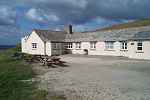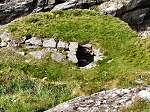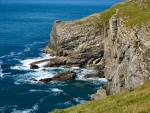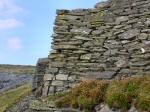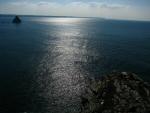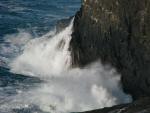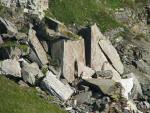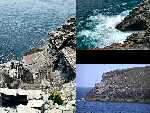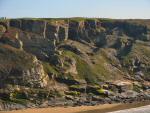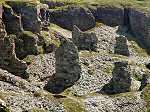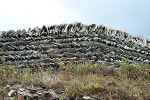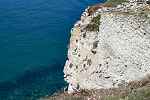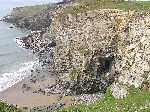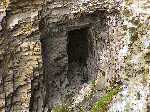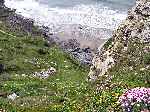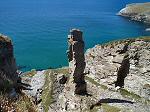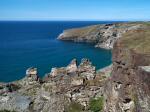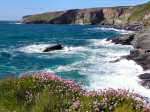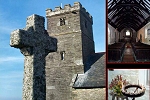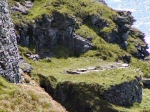Walking from Tintagel Castle to Trebarwith
Strand, through the lovely cliff side scenery of Glebe and Treknow cliffs,
you will pass St. Materiana, a fine old Norman
Church. Further on the coastal path also leads you through the remains
of a once thriving slate industry. There is evidence that slate has
been quarried here since 1650 and the last, Long Grass Quarry, did not
close until 1937. The slate has been worked in two ways, the traditional
digging down from above to form large quarries as was done in Lanterdan
and West quarries; and,
north of Hole Beach, small quarries working the actual cliff side. In
Lanterdan quarry there is a tall pinnacle of rock left behind (left)
as the slate in the pinnacle was of inferior quality. Shorter pinnacles
were left in West Quarry
for the same reason. Masonry strongpoints were built in the smaller
cliff face quarries to support timber structures which lowered cradles
and buckets down the cliff face. The slate itself was exported from
Tintagel Haven on boats 'hobbled' in a similar fashion to that used
at Boscastle. A wharf was also constructed at Penhallic
Point where the cliff edge was trimmed to
form a 100ft vertical face. Ships would
lie against this face in the natural deep-water berth whilst the
slate was lowered by crane down into their holds.
If you walk towards Trebarwith
Strand from Tintagel Head you will pass:
You will, no doubt, also use and pass rights of way across the fields
that lie between the village of Treknow and the old quarries. These
four paths were the ones used by the men working in the quarries. The
signs of their passing can be seen on the well-worn steps of the slate
stiles over the stone walls of the fields. Many of these walls are built
of slate in the local 'curzyway'
style where the slates are laid diagonally in a chevron design with
horizontal sections at regular intervals for added strength.
Lanterdan and West Quarries
These two quarries were worked in the traditional quarrying manner
and are notable for the huge amounts of slate that have been extracted
here. The tall stacks of rock were left behind by the quarrymen
because they are composed of inferior slate. The remains of old
tram lines and buildings can be seen though these quarries are long
since disused.
Cliff-face Quarrying
In the cliff face quarries, masonry
strongpoints on the cliff tops supported 'poppet heads' and
'tail masts'. Cable ways were laid between these with the tail
mast forming the anchor. Travelling cradles moved along these
cables and from these buckets and hoops could be lowered down the face
of the cliff to the men working below. Huge chunks of slate were
then hauled up the cliffs, usually by horses or donkeys, and split into
smaller roofing slates in the splitting sheds. Tintagel
youth hostel has been converted from the old
office, engine and blacksmith's shop of Long Grass Quarry, which was
the last working quarry here closing in 1937. In the previous
year a man was killed whilst working here. Another tragic accident happened
in 1886 when three men were killed when the rock they were drilling,
broke off and fell into the sea taking them with it. Opposite the youth
hostel is Gull
Point Quarry and the round
platform near the top is where a blindfolded donkey used to circle
operating the winding gear. Looking across the cove from the hostel
you can see the masonry strongpoints and the two deep, vertical bites
where the quarrymen have taken the slate. Lambshouse Quarry operated
between the two sites and Gillow quarry lay between Long Grass Quarry
and Tintagel Castle. Past Penhallic point and its disused wharf
can be found the remains of Dria and Bagalow quarries.
|



